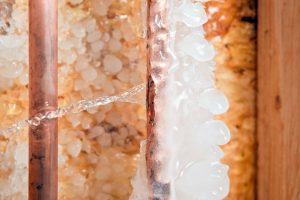It’s no secret that temperatures here in Okotoks can dip well below freezing during the winter – and the season is officially upon us! It’s important to take action to protect your pipes from freezing or else you’ll be left calling our team for emergency plumbing services in Okotoks.
You can keep reading to learn some of the proactive steps you can take so that frozen pipes don’t throw a wrench in your winter plans. If you do find yourself facing frozen pipes or suspect that some of your pipes froze, let us help. We may be able to help thaw your pipes before they burst and cause water leaks.
1. Insulate Exposed Pipes
Pipes that are located in exposed spaces like your basement or attic, crawlspaces, and exterior walls are more susceptible to freezing as temperatures drop. Adding insulation to pipes in these areas is one of the most effective ways to keep them from freezing. Be sure to use foam insulation specifically designed for pipes to achieve the best results.
You can boost protection further by checking for and sealing any gaps or cracks near pipes that may expose them to additional cold air. Invest in professional repairs when needed or apply caulk or expanding spray foam if you can do so safely.
This includes covering spigots that are attached to the outside of your home. You can purchase special foam covers that secure around exterior water lines to protect them from extreme cold. It’s a good idea to keep these outdoor faucets covered for the entirety of the winter season just to be safe. Otherwise, you run the risk of forgetting when temperatures drop unexpectedly.
2. Maintain Heat Indoors
Set your thermostat to a reasonably warm temperature, even when you’re away or traveling to help protect your pipes from freezing. Ideally, you want to set your thermostat no lower than 16°C at any point for heating. This ensures that your interior pipes stay warm enough that water standing in the lines doesn’t freeze.
Setting your thermostat any lower or turning it off completely increases your risk of frozen pipes. You can take an additional step and open the cabinets under sinks in your kitchen and bathrooms so that heat from the air can reach these pipes better to warm them up.
3. Drip Your Faucets
Turn every faucet in your home on so that water is dripping every few seconds to keep water moving through all of the lines. Moving water won’t freeze as easily as water that is standing in the lines. Keep in mind that you have to strike a balance between dripping faucets and running up your utility costs for water usage. Use this tip during extremely cold days when your pipes are most likely to freeze.
Contact Ace Plumbing and Heating today to schedule an appointment for your plumbing and HVAC needs. Happy Today or You Don’t Pay!

